ArchBook: Architectures of the Book
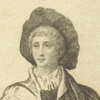
Published 18 July 2013
Corrected and updated 5 February 2022
Figure 1
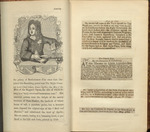
Click For Larger Image
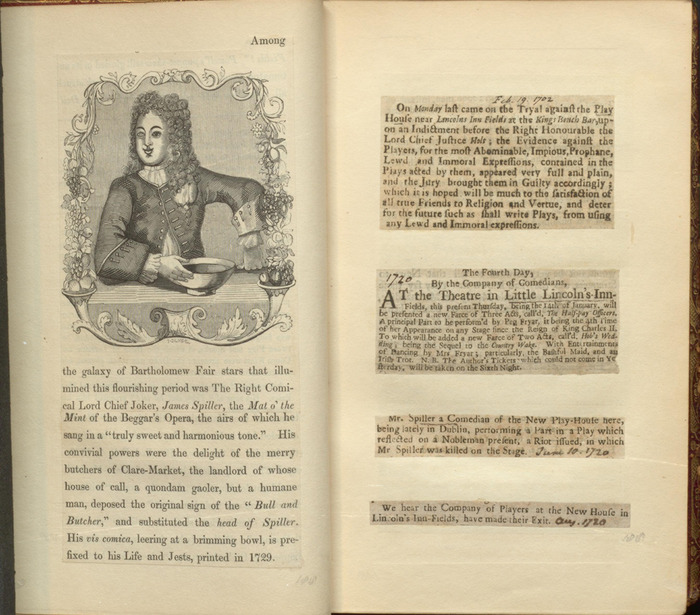
The lives of the playersAn example of Grangerizing using a portrait and newspaper clippings. From Volume 2 of "The lives of the players. In two volumes" by John Galt. Image courtesy of Thomas Fisher Rare Book Library, University of Toronto.CLOSE or ESC
Grangerizing is the expansion of a published book by the addition of illustrative images such as prints and etchings, as well as textual material such as correspondence and playbills. The added images are affixed on extra pages rebound into the codex (i.e. interleaves) or simply added on top of the existing text (see Figure 1). This visual form of annotation draws its name from James Granger, an eighteenth-century collector, clergyman, and writer whose early use of the technique became erroneously rewritten as its origin.
Figure 2

Click For Larger Image
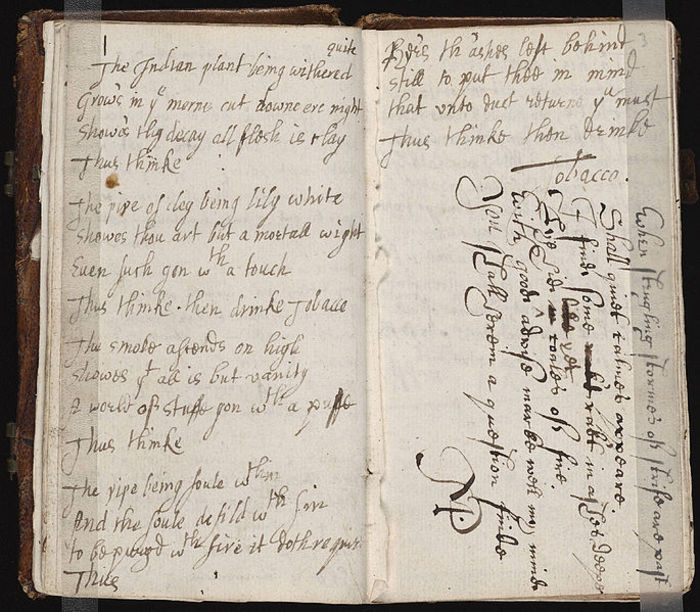
Scrapbook, 17th centuryExample of a mid-seventeenth century scrapbook showing poems in multiple hands, author unknown. 1 volume, 190 pages, 13 x 7 cm. Image courtesy of James Marshall and Marie Louise Osborn Collection, Beinecke Rare Book and Manuscript Library, Yale University.CLOSE or ESC
Figure 3
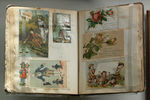
Click For Larger Image
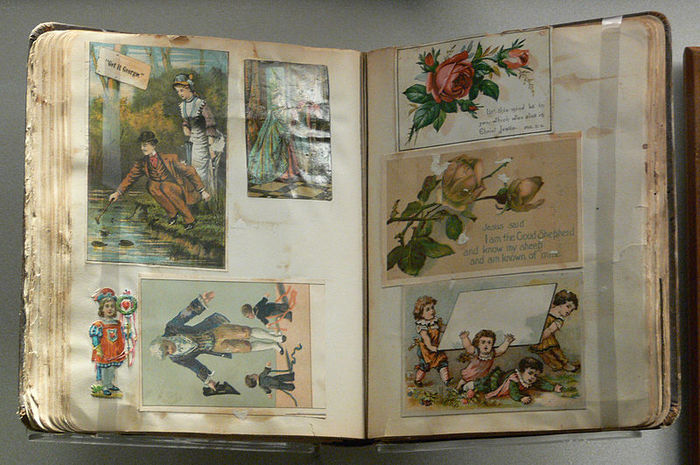
Scrapbook, 19th-early 20th centuryExample of a 19th or early 20th century scrapbook with various pasted pieces. Image courtesy of The Women's Museum, Dallas, Texas, and Wikimedia Commons.CLOSE or ESC
Grangerizing sits temporally and materially between commonplacing (see Figure 2) and scrapbooking (see Figure 3), and occupies a nearly synonymous space with extra-illustrating. Although all these terms sometimes overlap, Grangerizing specifies a deliberate attempt to augment or rewrite a text via images, while extra-illustrating is a broad term covering any post-publication insertion of additional illustrative material into a book, commonplacing was largely concerned with collecting written material such as favorite quotations, and scrapbooking largely refers to the more recent practice of using cheaply available illustrative material to create new books.
Even during the period when Grangerizing often produced a means of displaying wealth and taste, a careful and often deep reading experience of the text was necessary to craft the new book, situating the technique as both book art and reading practice. Unlike other forms of readerly annotation such as recording marginal notes and disputations, Grangerizing shows as much about readers’ attitudes towards books as material objects as it does about reading practices in the eighteenth and nineteenth centuries. Grangerizing saw a vogue in the eighteenth and nineteenth centuries and was originally a hobby pursued by those with the wealth and time to spend procuring expensive, rare illustrations and annotating texts such as biographies and histories of specific locations. The technique’s popularity affected the price and quality of the book trade’s offerings, leading to controversy among practitioners and book collectors. Interest in the technique as a means to display status died off by the end of the nineteenth century because of the introduction of cheaper, better printing techniques that made images and books available to persons of every class, but the practice survives today as an artistic technique.
Building on earlier and contemporary examples of image-privileging texts, Grangerizing’s practice of undoing a codex’s binding and exploding the book makes it a precursor to all sorts of later explorations of the codex’s form and visual features, including transmedia novels, the livre d’artiste, and artists’ books. Grangerizing also stretched the possibilities of annotation, as collectors used the technique both to acknowledge and to widen the discourse field around a topic, sometimes effectively rewriting a book's focus through the addition of various media (see Figures 4 and 5 for two examples of Shakespearean augmentation).
Figure 4
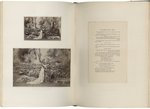
Click For Larger Image

Midsummer's Night DreamShakespeare's plays were a popular foundation for Grangerizing, as with this example page from an 1888 copy of Midsummer Night's Dream created for theatrical manager and playwright John Austin Daly to commemorate a production. The book contains a variety of media related to both the text and the performances, including 86 photographs of the cast and scenery, 41 original costume designs, letters about the production, playbills printed on satin, programs, and the text of the play in seven leaves from the second folio of 1632. Image courtesy of Folger Shakespeare Library.CLOSE or ESC
Figure 5

Click For Larger Image
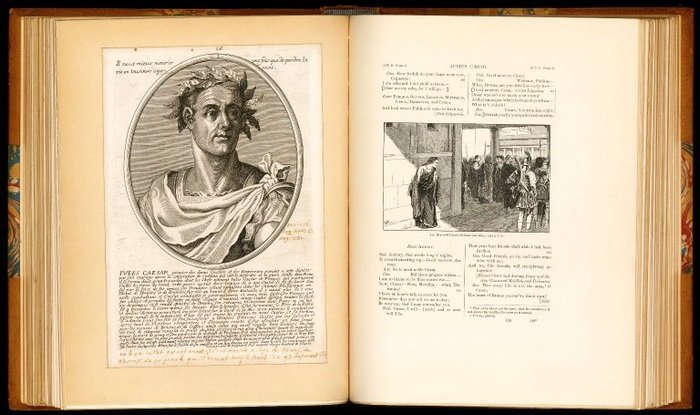
The Works of William ShakespeareShakespeare's works were popular foundations for Grangerizing to commemorate performances (as with Figure 5), but another frequent type of augmentation—the addition of description and portraits for historically based characters—can be seen in this example from a 1888 copy of The Works of William Shakespeare augmented by Augustin Daly in 1893. Image courtesy of Folger Shakespeare Library.CLOSE or ESC
Notes for a 2010 exhibition of Grangerized and extra-illustrated books at the Folger Shakespeare Library in Washington, D.C. tell us “the concept is simple: identify significant people, places, and things in a printed text, collect pictures of them, then insert the pictures as visual annotations to the text.”1 Between its two main acts of collection and annotation, Grangerizing shares many traits with earlier book arts techniques. Commonplacing—the collection of quotations, figures, and other, usually written miscellanea into personal books—predates Grangerizing’s collection of visual materials into personal books by several hundred years, occurring before widespread improvements to printing and binding allowed any large scale of book production.2
Figure 6

Click For Larger Image
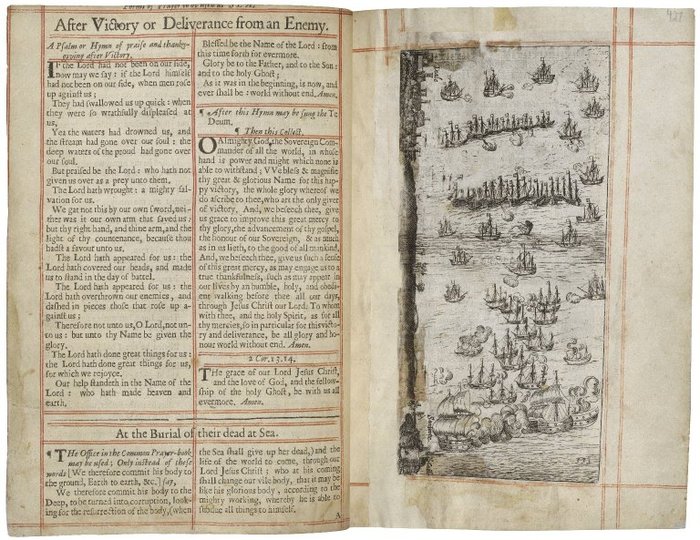
Book of Common PrayerA 17th-century Church of England Book of Common Prayer where “A Psalm or Hymn of praise and thanksgiving after Victory or Deliverance from an Enemy” has been augmented by the addition of an engraving of the 1639 Battle of the Downs (October 1639). Image courtesy of Folger Shakespeare Library.CLOSE or ESC
Where commonplacing was mainly textual (usually quotations recorded in ink in the owner’s hand), Grangerizing was hypermediac, pulling in diverse material including etchings, prints, playbills, paintings, and correspondence (see Figure 6). Another notable difference between the techniques is the created object’s intended role. Commonplace books were mostly private creations, “essentially a filing system” for the owner’s favorite quotations and handy data.3 Grangerizing shifted the purpose of production to public display, with a polished object as its goal.
Extra-illustration might be considered another precursor to Grangerizing or a broader technique encompassing it, though extra-illustration occurred nearly contemporaneously with Grangerizing and is often treated as a synonym for that technique (e.g. in the OED).4 Extra-illustration refers to any act of adding illustrative material to a published codex, while Grangerizing sometimes specifies a deliberate attempt to augment or rewrite a text. As both techniques of adding illustrations to printed books caught on, publishers began selling items misappropriating the popular word “extra-illustration” to mean that a book contained more than the usual number of images. The vogues for print collecting and illustration overlapped, and the word “illustration” itself has a varied history, meaning “an elucidation” rather than “an illustrative picture” until 1816.5
The popularity of working with Shakespeare’s plays and the Bible provides a wealth of examples of overlapping book arts practices from the earliest printed books onward; for example, the seventeenth-century Little Gidding “Harmonies” and the early nineteenth-century Jefferson Bible were both thorough reworkings of the New Testament Gospels via the hacking of the original published form of the book.6 These two works also illustrate the difficulty of categorizing such productions across the centuries, as each was created by cutting and pasting pieces of text and image into a new codex (as with scrapbooking), yet shows the orchestration of a coherent narrative whole typical of a Grangerized book. These ambiguities of classification resulted in a continuing uncertainty as to what librarians should label as commonplaced, extra-illustrated, Grangerized, or scrapbooked, and thus tracking the development of these actions as separate techniques and accurately categorizing new discoveries are difficult tasks.7
Putting the Granger in Grangerizing
Figure 7
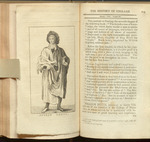
Click For Larger Image
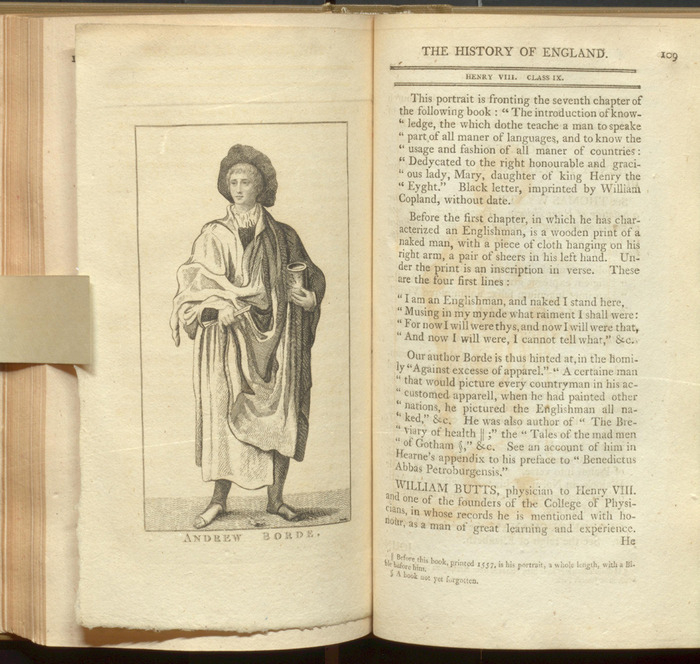
Biographical History of EnglandBy Rev. James Granger, augmented with portrait image. Image courtesy of Thomas Fisher Rare Book Library, University of Toronto.CLOSE or ESC
James Granger (1723-1776) was a clergyman and collector of print and engraved authors’ portraits; his major work was the lengthily titled 1769 Biographical History of England, from Egbert the Great to the Revolution, Consisting of Characters Dispersed in Different Classes, and Adapted to a Methodical Catalogue of Engraved British Heads. Intended as an Essay towards Reducing Our Biography to a System, and a Help to the Knowledge of Portraits; with a Variety of Anecdotes and Memoirs of a Great Number of Persons Not to Be Found in Any Other Biographical Work. With a Preface, Showing the Utility of a Collection of Engraved Portraits to Supply the Defect, and Answer the Various Purposes of Medals (see Figure 7). The Biographical History contains brief biographies of famous people alongside written lists of their portraits. While a fad grew around the addition of the actual portrait images into personal copies of this work, Granger’s innovation was to produce catalogues of the existing portraits of persons named in his text; these lists provided an antidote to the more easily accessible, but often poorly struck images of famous persons on medals.
An apocryphal story repeated by the OED attributes the Grangerizing technique’s innovation to Granger, but he neither invented the technique, nor was the first author to have his work Grangerized, nor explicitly invited Grangerization of his work. Moreover, bibliophiles blamed Granger for causing the destruction of books and the rising price of image prints.8 Some of the confusion seems to stem from a misunderstanding of remaining copies of his Biographical History. The OED reports that Granger’s book contained blank pages intended to receive visual additions from readers. Some surviving copies of the first edition were printed on only one side of the leaf, with the resulting blank spaces intended for textual annotations from expert collectors, such as lists of further portraits that could be folded into print copies of later editions; only editions of the book printed after Granger’s death (when Grangerizing was already a popular past-time) were created with the technique in mind.9 Together with the Grangerizing that became popular with the work, the features of these two versions of Granger’s book led to this misattribution.10
"Book Ghouls"
The popular hobby of Grangerizing initiated a schism in the world of bibliophiles; a group that had long valued the preservation of fine examples of the book arts as they were published now found many of its members elevating not what a book already was, but what it could be. Devotees of Grangerizing argued that their reuse of visual material from other books was an “exquisite handicraft” that made use of texts that would otherwise have been junked.11 This reuse of multiple books in the remaking of one codex is another factor where Grangerizing and extra-illustration tended to differ; Grangerizers freely cannibalized other books to find the best images for their chosen text, while “extra-illustration” was a term usually applied to techniques that did not leave other books mutilated.12 This cutting up of books not only caused a divide among book collectors, but created a controversy in the general public; where the Grangerizers saw their work as curation and preservation of the best in image and text, others pointed to the increasing likelihood of encountering mutilated books with images (and often nearby text) snipped out.
For those book collectors whose goal was to preserve fine and historically interesting volumes as they were created, Grangerizing was a perversion of a long-celebrated activity–according to an 1892 critic, “breaking up a good book to illustrate a worse one.”13 The author of the 1809 treatise The Bibliomania speaks of “the mischief which this passion for collecting prints has occasioned.”14 Bibliographic discussions from the eighteenth and nineteenth centuries are replete with colorful invective against the Grangerizers’ depredations:
The Book Ghoul . . . is a collector of title-pages, frontispieces, illustrations, and book-plates. He prowls furtively among public and private libraries, inserting wetted threads, which slowly eat away the illustrations he covets; and he broods, like the obscene demon of Arabian superstitions, over the fragments of the mighty dead. He divides this variety into three classes: The antiquarian ghoul who steals title-pages and colophons. The aesthetic ghoul who cuts illuminated initials out of manuscripts; and the petty, trivial, and almost idiotic ghoul of our own days, who sponges the fly-leaves and boards of books for the purpose of cribbing the book-plates. This type is still regarded as a Book-Ghoul, even though his aim is grangerization.15
The wealth required to not only locate and purchase images matching the needs of a Grangerized book, but also be willing to cut up a work containing a needed image (thus reducing the expensively procured source text’s value and readability) points to a limited class of hobbyists capable of pursuing this technique.
Economics of Grangerizing
In its heyday, most Grangerizers were upper-class British males, and the technique was not widely pursued outside of Britain until near the end of its vogue in the mid-1800s.16 Records of Grangerizing activity emphasize the display aspect over the artistic process: “a way for gentlemen to demonstrate their wealth and taste by essentially recreating a book with costly prints.”17 Scanning the names of a few well-known Grangerizers points to the economic and social requirements for engaging in such activities:
- George Weare Braikenridge (1175-1856), who added thousands of portraits to Granger’s Biographical History, and reworked William Barrett's History and Antiquities of the City of Bristol into a 36-portfolio collection of engravings, prints, writing, and 1400 drawings and watercolors (many of which were specially commissioned for the Grangerization).18
- Lieutenant-General William Dowdeswell, Governor of the Bahamas 1797-1801.19
- Alexander Hendras Sutherland, who (with additional labor from his widow) produced a work “bound in 57 elephant folio volumes . . . contain[ing] 18,742 prints and drawings by 1,457 known artists.”20
The first Grangerizers required a trifecta of free time, money, and the social connections necessary to locate the needed images, but over time the book trade began to cater to the hobby both through gathering images for sale and offering books pre-bound with blank pages. A calculated rise in the cost of images countered their greater availability on the market; as the vogue for Grangerizing spread, the cost of books containing images (especially the engraved portraits sought for Granger’s Biographical History) quintupled in price, and “few could be found unmutilated.”21
For a few decades, Grangerizing was both popular and prohibitively expensive; by the mid-1800s, though, innovations in printing radically widened the circle of who could participate. Suddenly, everyone had access to both affordable books and images–although the latter, often clipped from newspapers and magazines, were frequently of lower quality. Grangerizing’s reliance on locating rare prints or specially commissioning art were no longer barriers to taking up a hobby involving repurposed books and art, and a new pursuit–scrapbooking–was born. Old-guard Grangerizers responded by emphasizing the cost and rareness of their materials, only using images from the new periodicals if they could split the paper (removing the printing on its back, which often showed through), a procedure too expensive for the non-wealthy Grangerizer.22 Despite these strategies, the vogue of Grangerizing vogue ended with its loss of social exclusivity.
Scrapbooking is the process of making completely new books by pasting blank pages with newspaper columns, obituaries, advertisements, drawings, and other images that the maker for some reason wishes to preserve. Scrapbooks can be thematic or miscellaneous, rather like an image-inclusive version of the old technique of commonplacing. Where Grangerizing involved the careful and expensive creation of image-stocked codices for public display, scrapbooking was a distinctly personal and cheap hobby, though its pursuit was certainly not without care or craft. Scrapbooking was a more egalitarian activity than Grangerizing, pursued without exclusivity of class, gender, or age; in some families, each new periodical or printing was passed around so that each member could remove the pieces pertinent to his or her personal scrapbook.23 While scrapbooks were treasured objects often shared with visitors and friends, the hobby was much less about public ostentation than Grangerizing and more about art for art’s sake and the joy of collecting and organizing. This shift in emphasis led the way for Grangerizing to become less a symbol of status and more a thoroughly artistic technique.
Beyond Scrapbooking: Grangerizing as Modern Book Customization
As much as Grangerizing gets called out for being a class-limited pursuit, the technique was not entirely about displaying wealth and power; even the most stereotypical Grangerizers were pushing the limits of traditional codex use. “The willfully tangential quality of the illustrations, illustrating terms that even an indexer would skip, suggests that [a Grangerizer] was not seeking to make his copy of the text more useful, but rather was playing with the skeleton of the book, improvising far away from the melody.”24 Others Grangerized with a non-traditional but declarative purpose, as with Alexander Meyrick Broadley’s 1903 expansion by fifteen volumes of Percy Fitzgerald’s Life of David Garrick into the re-titled Age of David Garrick.25
Because of changes in printing, the rise of scrapbooking, and changes in class differences, Grangerizing drifted away from a form of displaying wealth to a technique of hacking the book: rewiring, reconsidering, and rebelling against the conventions of the traditional print codex.26 We can see Grangerizing’s legacy of altering books and emphasizing the visual in the nineteenth-century idea of the “Total Work of Art” (TWOA), Yeats’ “Whole Book,” and similar aesthetic approaches to literary publication.27
These forms attempted to fuse craftsmanship and visual appeal with similarly stylized content. As with later artists’ books, the TWOA was conceived as a linking of form and design with content; the TWOA periodicals of the 1890s, however, differed from artists’ books in their fusing of the avant-garde with a heavy emphasis on commercial success. The features that set these periodicals apart as hacks of the typical serial publication were meant to attract an audience willing to pay for craft and luxury in their reading: “Bindings, fonts, lay-out, illustrations and other paratextual features all combined to achieve the ambitions of the editors who hoped that this ploy would help their publication escape the ephemeral fate of the average periodical.”28 Sometimes, the target was an audience more interested in displaying the texts as objects than in engaging with them as readable works, a legacy of both Grangerizing and the Arts and Crafts movement’s Revival of Fine Printing.29
Grangerization continues today as an artistic technique for rewriting the purpose of the original text, as with Pinckney Marcius-Simons’ painting over the pages of A Midsummer Night’s Dream.30 Modern e-lit and research on digital reading often carry over knowledge about the affordances of the print book when exploring the possibilities of digital space;31 The legacy of Grangerizing, as a technique that explored the limits of codex form, supports these creative and critical engagements with digital space.
Blake, Erin C., and Stuart Sillars. Extending the Book: The Art of Extra Illustration. Curated exhibit. Washington, DC: Folger Shakespeare Library, 2010.
Claes, Koenraad, and Marysa Demoor. "The Little Magazine in the 1890s: Towards a 'Total Work of Art.'" English Studies, 91.2 (2010): 133-149.
Ferrell, Lori Anne. The Bible and the People. New Haven, CT: Yale University Press, 2008.
Garvey, Ellen Gruber. "Imitation Is the Sincerest Form of Appropriation: Scrapbooks and Extra-Illustration." Commonplace, 7.3 (2007). Accessed January 27, 2022. http://commonplace.online/article/imitation-is-the-sincerest-form-of-appropriation/.
"Granger, James." Dictionary of National Biography. Vol. 22. Edited by Leslie Stephen. London: Smith, Elder, & Co., 1890. 372-74.
Jackson, Holbrook. The Anatomy of Bibliomania. 2nd printing. New York: Farrar, Straus and Co., 1950.
Jackson, H. J. Marginalia: Readers Writing in Books. New Haven, CT: Yale University Press, 2001.
"The Life and Morals of Jesus of Nazareth." Reassembled by Thomas Jefferson from the New Testament Gospels ca. 1819. Currently owned by the Smithsonian National Museum of American History.
Kirschenbaum, Matthew. "Bookscapes: Modeling Books in Electronic Space." Paper presented at the Human-Computer Interaction Lab 25th Annual Symposium, University of Maryland, May 28-29, 2008.
Lang, Andrew. The Library. London: Macmillan, 1881.
Little Gidding concordance. New Testament Gospels. Little Gidding, 1630. A 1275.5. Houghton Library, Harvard University, Cambridge, MA. http://nrs.harvard.edu/urn-3:FHCL.HOUGH:10090806.
Petrucci, Armando. Writers and Readers in Medieval Italy. Edited and translated by Charles M. Radding. Yale University Press, 1995.
Stoddard, Sheena. Bristol Before the Camera: The City in 1820–30. Bristol: Redcliffe, 2001.
Stooks Smith, Henry. The Parliaments of England. 2nd ed. Edited by F. W. S. Craig. Chichester: Parliamentary Research Services, 1973.
Tredwell, Daniel M. A Monograph on Privately-Illustrated Books. A Plea for Bibliomania. Lincoln Road, Flatbush, Long Island: Privately Printed, 1892.
Visconti, Amanda. "'I Must Create a System': Hacking the Book from Blake to the Blake Archive." May 2012. http://digitalliterature.net/bookhacking.
Andrews, William Loring. Of the Extra Illustration of Books. Reproduction of 1900 printing. Charleston, SC: Nabu Press, 2010.
Ault, Donald. "Re-Visioning William Blake's The Four Zoas." ImageTexT 3, no. 2 (2007). Accessed February 5, 2022. https://imagetextjournal.com/re-visioning-william-blakes-the-four-zoas/.
Blades, William. The Enemies of Books. 2nd ed. London: Elliot Stock, 1888. Republished by Project Gutenberg. Accessed February 5, 2022. https://www.gutenberg.org/files/1302/1302-h/1302-h.htm.
Browne, Irving. An Account of Some Books Containing Extra Illustrations, in a Private Library. Reproduction of 1874 printing. Charleston, SC: Nabu Press, 2012.
Drucker, Johanna. "Artists' Books Past and Future." In Figuring the Word: Essays on Books, Writing, and Visual Poetics, 167-212. New York: Granary Books, 1998.
Drucker, Johanna. The Century of Artists' Books. New York: Granary Books, 1995.
Drucker, Johanna. "Graphesis: Visual Knowledge Production and Representation." Poetess Archive Journal 2, no. 1 (2010): 1-50.
Frye, Northrop. "Poetry and Design in William Blake." Journal of Aesthetics and Art Criticism 10, no. 1 (1951): 35-42.
Krajeski, Jenna. "Good Ruined Books and Bad Ruined Books." New Yorker. March 12, 2010. Accessed February 5, 2022. http://www.newyorker.com/online/blogs/books/2010/03/good-ruined-books-and-bad-ruined-books.html.
McGann, Jerome. "Visible and Invisible Books: Hermetic Images in N-Dimensional Space." New Literary History, 32.2 (2001): 283-300.
Mellby, Julie. "Asher B. Durand: Extra-Illustrated or Grangerized?" Graphic Arts: Exhibitions, acquisitions, and other highlights from the Graphic Arts Collection. Princeton University Library. July 18, 2009. Accessed February 5, 2022. https://www.princeton.edu/~graphicarts/2009/07/asher_b_durand_extra-illustrat.html.
Peltz, Lucy. "The Cut and Paste of English History." Country Life 24, no. 31 (1998): 66-68.
Peltz, Lucy. "The Extra-Illustration of London: Leisure, sociability and the antiquarian city in the late-eighteenth century." Ph.D. thesis, Manchester University, 1997.
Peltz, Lucy. "The Extra-Illustration of London: The Gendered Spaces and Practices of Antiquarianism in the Late Eighteenth Century." In Producing the Past: Aspects of Antiquarian Culture and Practice, 1700-1850, edited by Martin Myrone and Lucy Peltz, 115-34. Farnham, UK: Ashgate, 1999.
Shillingsburg, Peter L. From Gutenberg to Google: Electronic Representations of Literary Texts. Cambridge: Cambridge University Press, 2006.
Wark, Robert R. "The Gentle Pastime of Extra-Illustrating Books." Huntington Library Quarterly 56, no. 2 (1993): 151-65.
